Last weekend, Star Trek superfan Michael Gummelt took to the internet to announce that he had been invited to officially pitch his idea for a Star Trek TV show to Paramount Pictures. As laid out in exhaustive detail at his site Star Trek Uncharted , his concept would see a newly rebuilt Enterprise setting out on its standard mission (i.e., “To explore strange, new worlds”) but in a new galaxy (Andromeda) which has contacted our galaxy and claimed to be the source of all life in the Milky Way. Paramount became aware of this when they started copyrighting potential titles for next year’s Star Trek 3, and discovered that one potential title, Star Trek Beyond, was being used by Gummelt. He’s since renamed it Star Trek Uncharted.
Of course, CBS actually has the TV rights, not Paramount, and executives for Skydance Productions, which produced Star Trek Into Darkness and are producing Star Trek 3, just told reporters that the legal tangles preventing a new series are “wildly, wildly complicated.” Still, Gummelt is now unique among fans, “As far as I know, this is the first time a fan (not an established industry insider) has been invited to pitch a Star Trek TV series.”
True (probably), but once upon a time any amateur could submit a spec script to a Star Trek TV show and have it end up on the air. Beginning in 1989 when Michael Piller took over as Next Generation’s Head writer, any non-professional, unrepresented writer could submit up to two unsolicited scripts, at which point anything else had to be submitted through an agent. Such freelance work was nothing for TV, but opening it up to anyone outside of the Writers Guild and talent agency pool was unprecedented. The volume of unsolicited script submissions was high (“over 5,000 spec scripts for the final season of Next Generation” according to script coordinator Lolita Fatjo) but the acceptance rate was remarkably low. As Brannon Braga recently told the Nerdist Writers Panel podcast, “Michael Piller always had an eye out to find the next good writer that he could bring on board. So, he was constantly trying out people. Some of them turned out to be great and would join the staff, most would not. Re-writing those scripts would fall to us [on the writing staff
This policy carried over from The Next Generation to Deep Space Nine and Voyager before being suspended for Enterprise, Braga pointing to the piling lawsuits, “It caused also a lot of headaches from people who claimed we stole an idea. Sometimes they would just pay those people out, Paramount would, because it was a hassle. “ But now that Paramount has at least very briefly revived this policy by allowing a non-union, non-industry professional pitch them an idea for a show, who were some of the writers who actually got their start in the industry submitting spec scripts to Star Trek?
René Echevarria
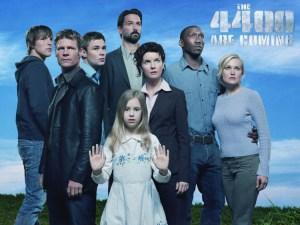
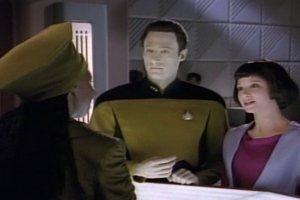
Data gets a daughter!
He was subsequently hired as a TNG staff writer, credited for 30 episodes. He transferred to DS9 where he co-wrote the Original Series homage “Trials and Tribble-ations.” He subsequently wrote for Dark Angel and Medium and co-created the USA series The 4400 with Scott Peters. He helped developed MTV’s Teen Wolf, and he served as showrunner for Terra Nova after the original showrunner was fired.
Jane Espenson
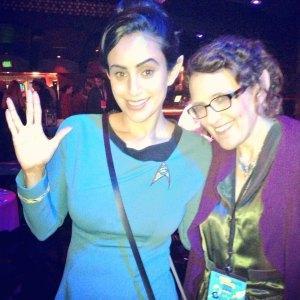
Espensen with a Star Trek fan
We know her as one of Joss Whedon’s go-to writers on Buffy the Vampire Slayer, Angel and Firefly, and since then she’s racked up writing credits ranging from Battlestar Galactica to Once Upon a Time to Game of Thrones. She created Warehouse 13, and currently has a web series called Husbands. But it all started with Star Trek, as she explained in an interview quoted by io9, “I was in grad school when I learned you could submit scripts to Star Trek: The Next Generation without having to have an agent as intermediary. I submitted three spec episodes of Star Trek: The Next Generation and was invited in to pitch episode ideas… I was already a huge fan of the show and of the genre in general. I love metaphorical storytelling, which is at the heart of scifi – this is our world, but looked at through a lens.”
This didn’t lead to a long life as a Star Trek writer. Despite her regular pitches to TNG, the only credit she ever received was for a story contributed to DS9. However, it was off of that experience that she slowly built an impressive career.
Bryan Fuller

Trent Christopher Ganino
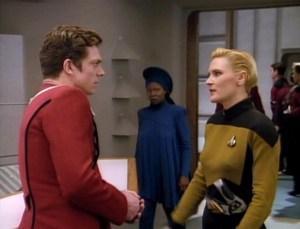
Ronald D. Moore
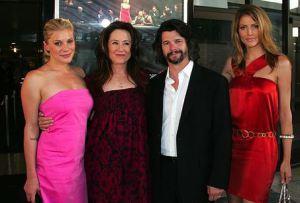
Ronald D. Moore with the women of Battlestar Galactica
He currently has Outlander on Starz. He used to have Battlestar Galactica. Before that he was a staff writer for Next Generation and Deep Space Nine, credited for 30 episodes of the latter. But if you go back far enough he was just a Star Trek fan. According to io9, “Legend has it Moore first infiltrated the TNG set when he was dating a someone in the production crew. During a tour of the set, he managed to slip the producers a written script that eventually became the TNG episode ‘The Bonding.’ He was hired a staff writer and eventually co-wrote the Next Gen movies Generations and First Contact. Sadly, he parted with Star Trek on bad terms after a very brief time with Voyager, transferring many of the things he felt Voyager should have been doing to his Battlestar Galactica reboot.
Robert Hewitt Wolfe
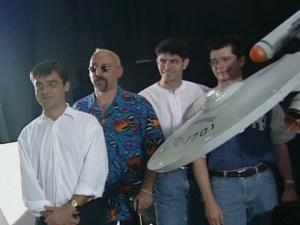
René Echevarria, Ira Steven Behr, Robert Hewitt Wolfe and Ronald D. Moore
He developed Andromeda from an idea left behind by Gene Rodenberry. He wrote for The Dead Zon, the Twilight Zone revival and co-produced the first season of The 4400. He developed the fantastic, yet short-lived SyFy series The Dresden Files. However, when he was fresh out of UCLA with a Master of Fines in Screenwriting Robert Hewitt Wolfe’s first big break was selling the script “A Fistful of Datas” (the holodeck western episode pitting Worf against a bunch of Datas) to Next Generation. The landed him a position on the Deep Space Nine writing staff where he stayed until leaving after the fifth season. During his tenure on the show, he often collaborated with producer-writer Ira Steven Behr, and the two later re-teamed on Alphas, which, similar to The Dresden Files, was an excellent, though short-lived SyFy series.
Sources: io9, Nerdist Writers Panel

